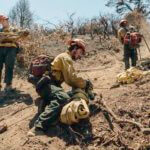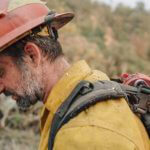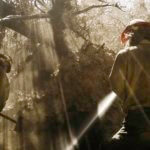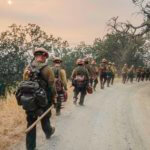
ABOUT THE FILM: “WILDLAND” takes viewers inside the lives and experiences of a group of men who battle wildfires. The television version of the documentary debuted nationally on PBS’ Independent Lens on October 29th which launched a grassroots theatrical on-demand campaign for the release of the 77-minute director’s cut of the film, set to begin exhibition in movie theaters January 16, 2019. Filmmakers Alex Jablonski and Kahlil Hudson’s cinematic version, shot using 6K cameras, includes nearly 30 minutes of additional footage.
* * *
By Amanda Rau
Films about wildland fire are uncommon, often tending toward the sensational. Documentary films about wildland fire are even more rare, and typically do not provide more than a view from a distance. Direct experience holds the greatest potential to accurately represent this profession, both the hands-on details as well as its transformative effects on people. As the filmmakers Alex Jablonski and Kahlil Hudson discovered, completing basic training and fitness testing to become wildland firefighters in order to fully embed with a Grayback Forestry initial attack hand crew, provided the best way to capture the intimacy between young men and fire.
It is not uncommon for a film about wildland fire to feature few if any women. It is none the less bold to give a film set within the last few years a name to remove all doubt. I contacted Alex Jablonski to express my dismay about the working title of the initial trailer release, Young Men and Fire, named after Norman Maclean’s seminal 1993 novel about the tragedy on the 1949 Mann Gulch Fire. He explained the intent in making a film intentionally focused on masculinity in modern America, inspired by a book set in the 1940’s, one that still remains relevant today. I contacted John Maclean, Norman’s son, to inquire about whether he was aware of the film, which he was not, and he proceeded to contact the filmmakers and post to Facebook about it, thereby generating a fair amount of backlash in response. John eventually took the post down after deciding that he did not want to force the issue, realizing that the filmmakers were humbled by the large response and were willing to consider changing the title.
By the time Wildland first aired on the PBS series Independent Lens, I had laid aside my grievances. A film intentionally focusing on masculinity with a nod to a book that explored in earnest the deeper underpinnings of fire’s draw had to be worth watching. What began as a film intending to explore fire and masculinity with a close-up lens ultimately succeeded at transcending gender with human experience.
In my early twenties, I was deep in my head and contemplating the nature of existence as a Philosophy undergraduate at the University of Oregon, I decided to complete the training and fitness requirements to become qualified as a wildland firefighter so I could work for a private contracting company on a hand crew. Among my female friends were a few who fought wildfires during the summer and returned with strong biceps and confidence evidenced in their swagger and the boots they continued to wear well after getting back.
I am still beholden to the memory of that that first encounter with a burned forest near Sisters, Oregon in 1999, spending hours mopping up in wonder of the transformation before me, and within. It was like Philosophy in action. Little did I know at the time that the seasonal work I relished, a welcome respite from academia, would become a lifelong endeavor, including well over a decade of federal service, culturally and socially distinguished from the contract firefighters who are the subject of Wildland, yet ultimately the same.Once any firefighter is engaged in the work, whether mopping up, conducting a burnout, or digging direct hand line, the distinctions between agencies and affiliations fall away.
Lacking the motivation of a criminal record, or desire to prove myself as a man to work in wildland fire — yet inspired by my friends and the desire to work outside and earn money to get through school — I too had countless experiences similar to those explored in Wildland. Exposing the side of wildland firefighting that enables a transcendence of culture and society, be it a rejection of status as a millennial or rising above a life of crime, the film demonstrates the transformative aspects of wildland fire and the subtle side of firefighting not often explored. The beauty of light passing through smoke filtered by the charred remnants of forest canopy at the golden hour, slow time passing on a cold black piece of steep ground, doing things you did not know you were capable of, the hustle of hotline, feeling exceptionally alive, waiting between fire assignments for that fire call, saying goodbye to people, pets, and places as you love for what may be several weeks or more, making tough decisions about risk and putting the fire out, making sure everyone goes home, discovering a part of yourself you did not know existed. In short, the film bears witness to the seemingly ineffable experiences of doing work that thousands of people experience in their own way every summer.
Wildland explores the wildland fire environment through the eyes of firefighters with grace, from the monotony of mop-up, to the intensity of direct attack. They range from young men looking for a chance to test their grit, to those looking for a second chance to live life on the right side of the edge. The filmmakers spent a summer working alongside the crew and filming, hanging out at the base, becoming one of them, thereby providing a uniquely intimate portrait, captured through honest stories and interviews of men with a common goal despite disparate backgrounds, working hard to overcome internal and external struggles at once. Cameo characters include Aidan and Charlie, who met at bible school and are united in a desire to overcome the malaise of their generation in favor of experience shepherded by Ray Bradbury’s Dandelion Wine.
The film explores the simultaneously ecstatic and imperfect experiences of life. We meet a former tattoo artist who knew he would soon be too old for this kind of work and had always wanted to do it, young men already caught in the downward spiral of the legal system trying in earnest to catch a break and find a way out, and older men like Crew Boss Tim Brewer leading and mentoring, having found their own redemption through a journey in wildland firefighting.

Wildland’s presentation of working class men as a lens through which to view masculinity in America is as transcendent as the element of fire in transforming these men into better people. The story of young women, as much as any marginalized group, finding their way in the world through work that transforms people alongside the landscape, could as easily be told, and hopefully will someday.
It would be an oversimplification to focus on the fact that this film portrays a certain kind of firefighter, akin to the men who were picked up off the streets and from the bar back in the early days to perform work that most were unwilling or unavailable to do, rather than those coming from federal, state, county, and municipal governments who make up the majority of the wildland firefighting workforce today. Firefighters are indeed a proud group, and would generally prefer to be portrayed as heroes, stewards, and professionals, before being cast as humans with troubles finding redemption in hard, dirty, dangerous manual labor. Yet as Ed Floate — the seasoned former smokejumper working for Grayback tasked with turning a motley crew of men into a fire crew capable of keeping up with the tough act of their peers in the public sector — so plaintively states, “Fighting fire is just long hours of hard, boring work punctuated by moments of sheer terror.” Wildland respects the element while illuminating the humbleness of the work itself.

The film ends abruptly and with an awkward transition, ultimately mirroring the way in which the life of a firefighter swings from being away from home, sleeping on the ground, living presently and in the moment with rules of engagement at times being the only unchanging aspect in the midst of uncertainty, and working long hours in a challenging environment with an awe-inspiring element, to suddenly being back in civilization.
Wildland does not try to glorify wildland firefighting, explore its tragedies, or critique, formulaic clichés all too commonly used to describe the element and the work. It offers a raw yet softened view, amplifying humanism over heroics, and vulnerability over ego, gently approaching harsh, difficult, and dangerous work to attune to the moments and reflections of men as they and the landscapes where they find themselves working change together.

+
About the Author
Amanda (Stamper) Rau started her career in fire management as a member of a 20-person handcrew in 1999. In 2001, after finishing her BA in Philosophy at the University of Oregon, she returned to fire management, working on hotshot crews, handcrews, and engines; as a fuels technician on the Deschutes National Forest; and assistant fire management officer in fuels management on the Ochoco National Forest and Crooked River National Grassland.
She studied Natural Resources at Oregon State University and completed a Masters in Natural Resources, Fire Ecology, and Management at the University of Idaho in 2012. She has since worked for the Prineville Bureau of Land Management as a natural resource specialist coordinating post-fire emergency stabilization and rehabilitation; as invasives program manager for the Deschutes and Ochoco National Forests and Crooked River National Grassland; and fire management officer for The Nature Conservancy’s Oregon Chapter. She’s a fourth-generation Oregonian whose family settled in the Willamette Valley in the late 1800’s.
